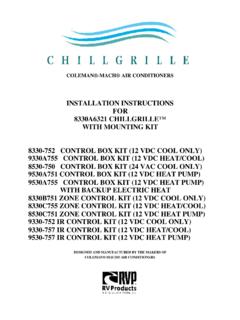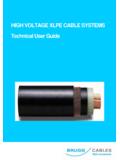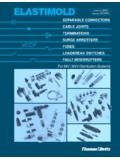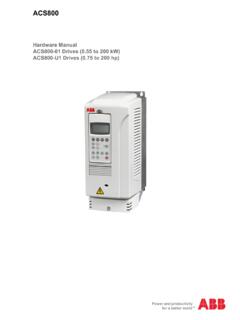Transcription of Testing Manual for Electrical Equipment
1 EPPM, Singapore, 20-21 Sep 2011 Testing Manual for Electrical Equipment Nahed Al-Hajeri 1and Anantha Madhavan 2 Abstract Quality Assurance (QA) refers to a program for the systematic monitoring and evaluation of the various aspects of a project, service, or facility to ensure that standards of quality are being met. The Equipment should be suitable for the intended purpose (fit for purpose) and errors/omission should be eliminated before putting the Equipment in paper has been developed to capture various aspects/requirements of inspection and test thru Factory Acceptance Test (FAT), Site Acceptance Tests (SAT) and to ensure quality of the Equipment /system. Keywords: factory acceptance test,routine test, site acceptance test, type test. Introduction The purpose of this Testing Manual is to provide guidelines for inspection and Testing of various Electrical Equipmentin compliance to relevant international provides information on procedures and Testing of Major Electrical Equipment s to be followed during Testing by engineers and also furnish evidence that an Electrical Equipment /device is free of inherent flaws or faults.
2 The tests on Equipment /system have been broadly categorized into two categories viz. Factory Acceptance Test (FAT) and Site Acceptance Tests (SAT). These tests have been tailored to ensure design, construction and performance requirements of each Equipment . This testingmanual includes High Voltage Switchboards, Low Voltage Switchboards, Transformer, Diesel Generator Sets, Induction Motors, Cables, Un-interrupted Power Supply (UPS), Ring Main Unit, Light Fittings, MOV Actuators, Isolator Switch and Earthing Systems etc. However in this Paper only highlights the high voltage cables and related test methods. Benefits Most useful practical information regarding the Factory Acceptance Tests (FAT) & Site Acceptance Tests (SAT) activities Highlights the type of test and their desired result values. These values are derived from the International standards, manufacturer s guidelines and good practical experiences.
3 It covers for all major Electrical Equipment . Simplifies procedures/integration 1 This can bereferred by company engineers to ensure the Testing and inspection Senior Engineer Projects, Kuwait Oil Company, Kuwait, Tel. +965 23861408 Fax. +965 23861084 Email. 2 Design Engineer, Kuwait Oil Company, Kuwait, Tel. +965 23861019 Fax. +965 23861084 Email. 175 Testing Manual for Electrical Equipment requirements are fulfilled. Improve the quality control of the project and simplify the procedures for engineers. Saving of material searching time. Factory Acceptance Tests (FAT) The Routine tests shall be made with each Electrical Equipment and, whenever practicable, at the manufacturer s works to ensure that the product is in accordance with the Equipment on which the type tests have been carried out. The factory acceptance tests consist of Routine, Type Tests and Special tests (project specific) as per company and International standards. Routine tests may comprise, Functional tests - Mechanical Operation Test -Test on auxiliary Equipment -Verification of correct wiring.
4 Dielectric Tests - It is presumed that every such Equipment would also comply with the type test, since design is identical. The factory inspection and Testing are conducted according to Company/international standards. The Inspection/ Testing of Electrical Equipment at Factory are carried out as per the flowchart attached below, 176 EPPM, Singapore, 20-21 Sep 2011 Flow Chart for Factory Acceptance Test (FAT) STEPS Ok 1) not Ok Ok 2) not Ok Ok 3) not Ok Ok 4) not Ok Ok 5) not Ok Ok 6)
5 Not Ok Ok not Ok 7) Incoming Equipment for Factory Inspection/ Testing (FAT) Internal Quality control Certificates shall be reviewed for any components failures and their Corrections Tests shall be carried out as per Standard, specified procedures Check for FAT Requirements as per Contract, Company Standard & approved ITP (Inspection Test Plan)Verify the information (Name Plate) and dimensions as per approved drawings Inspect for damages & missing parts Functional check including Mech. Mechanical Operation Test (If Applicable) insulation Resistance Test ( V Test) Before & After HV Test HV Test/ Dielectric Test (If Applicable, Standard to be followed)Corrective action to be taken by manufacturer to rectify and repeat the test procedure Value improvement to be done All Tests Results are Acceptable/Desired Values 177 Testing Manual for Electrical Equipment Yes 8) Test Methods and Desired Values In this paper we have highlighted only the High Voltage Cables.
6 Similar way it covers to all major Electrical Equipment s. Typical FAT Report- A typical Factory Acceptance Tests (FAT) formats for High Voltage Cables is as below; Sr. No. Description Procedure Desired Values / Results All internal quality control certificates shall be reviewed for any component failures and their corrections. 1. Visual Inspection Check the Conductor, General Construction and cable Identification etc. Ok. (as per approved document) 2. High Voltage Test AC Voltage test shall be applied between the conductor and the metallic shield (for 11KV cables 23KV for 5 minutes) at ambient temperature. No Breakdown 3. insulation Resistance Test The measurement shall be made between conductor and the cores & metallic shield. Value shall be Minimum 100 M 4. Partial Discharge Test The test voltage shall be applied between each conductor and the metallic shield. The partial discharge is measured at 11KV. No detectable discharge/puncture5.
7 Voltage Test for 4 Hours. The test voltage ( KV AC for 11KV shall be applied between conductors and the metallic shield. (Applied voltage shall be 4Uo for 4 hrs. for XLPE cables sample) No breakdown 6. Conductor and screen Resistance test The conductor resistance measured atambient temperature by Double bridge method. As per IEC 60502-2 (approved document) 7. Conductor/Armour wire examination Sampling : Outside diameter of conductor shall be measured at 3 points by caliper and average value shall be calculated. And diameter of armour wire shall be measured on 10% of total armour wires. As per IEC 60502-2(As per approved document) Test Passed Equipment - Dispatch clearance may be given 178 EPPM, Singapore, 20-21 Sep 2011 8. Measurement of thickness of insulation , bedding sheath and outer covering Sampling : i) Thickness of insulation shall be measured at 6 points by projector. ii) Thickness of bedding sheath shall be measured at 6 points by vernier caliber iii) Thickness of outer-covering shall be measured at 6 points As per IEC 60502-2(As per approved document) 9.
8 Measurement of overall diameter Sampling : cable overall diameter shall be measured by diameter tape. As per IEC 60502-2(As per approved document) 10. Hot set test for XLPE insulation Sampling : The test pieces shall be suspended in the oven and weight (20N/cm2) attached to bottom. After 15 Min. in the oven temp. The elongation calculated. Elongation under load : Max 175% Permanent elongation after cooling : Max 15% 11. Flame Retardant Test CAT A The mounted sample shall be placed in the test chamber; the test flame shall be applied for 40min. after which it shall be extinguished. The charred portion shall be measured in meters from the bottom edge of burner to onset of char. Max. length of charred portion should not exceed Test Results for FAT (Implementation): The tests carried out at manufacturer s facility for the following type of new cable , 3 Core 300 mm2 Copper Conductor, XLPE Insulated, Copper tape screened, PVC innersheathed, Galvanized Steel Wire Armoured and black PVC outer sheath 11KV cable to IEC-60502-2 and Flame Retardant to IEC 60332-3 Specification.
9 The test result values are tabulated below: Sr. No. Description Test Values/Results Remarks All internal quality control certificates are reviewed for any component failures and their corrections. 1. Visual Inspection Ok. (As per approved document). physical dimensions are verified Ok. 2. High Voltage Test AC Voltage test applied between the conductor and the metallic shield (for 11KV cables 23KV for 5 minutes) at ambient temperature. No Breakdown. Pass 179 Testing Manual for Electrical Equipment 3. insulation Resistance Test The measurement shall be made between conductor and the cores & metallic shield. Before and after HV test carried out the values are more than G (Giga Ohm). Pass 4. Partial Discharge Test The test voltage shall be applied between each conductor and the metallic shield. The partial discharge is measured at 11KV. No detectable discharge/puncture Pass 5. Voltage Test for 4 Hours.
10 The test voltage ( KV AC for 11KV shall be applied between conductors and the metallic shield. (Applied voltage shall be 4Uo for 4 hrs. for XLPE cables sample). No breakdown Pass 6. Conductor and screen Resistance test The conductor resistance measured atambient temperature by Double bridge method.( /Km at 20 Deg. ) Pass 7. Conductor/Armour wire examination Sampling : Outside diameter of conductor measured at 3 points by caliper and average value calculated. And diameter of armour wire measured on 10% of total armour wires. Pass 8. Measurement of thickness of insulation , bedding sheath and outer covering Sampling : a) Thickness of insulation measured at 6 points by projector. b) Thickness of bedding sheath measured at 6 points by vernier caliber c) Thickness of outer-covering measured at 6 points Pass 9. Measurement of overall diameter Sampling : cable overall diameter measured by diameter tape. Pass 10. Hot set test for XLPE insulation Sampling : The test pieces suspended in the oven and weight (20N/cm2) attached to bottom.




